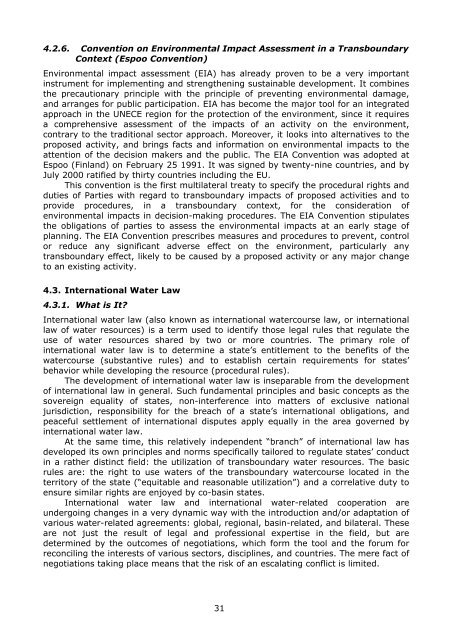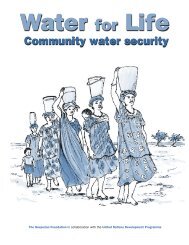Water security and peace: a synthesis of studies ... - unesdoc - Unesco
Water security and peace: a synthesis of studies ... - unesdoc - Unesco
Water security and peace: a synthesis of studies ... - unesdoc - Unesco
Create successful ePaper yourself
Turn your PDF publications into a flip-book with our unique Google optimized e-Paper software.
4.2.6. Convention on Environmental Impact Assessment in a Transboundary<br />
Context (Espoo Convention)<br />
Environmental impact assessment (EIA) has already proven to be a very important<br />
instrument for implementing <strong>and</strong> strengthening sustainable development. It combines<br />
the precautionary principle with the principle <strong>of</strong> preventing environmental damage,<br />
<strong>and</strong> arranges for public participation. EIA has become the major tool for an integrated<br />
approach in the UNECE region for the protection <strong>of</strong> the environment, since it requires<br />
a comprehensive assessment <strong>of</strong> the impacts <strong>of</strong> an activity on the environment,<br />
contrary to the traditional sector approach. Moreover, it looks into alternatives to the<br />
proposed activity, <strong>and</strong> brings facts <strong>and</strong> information on environmental impacts to the<br />
attention <strong>of</strong> the decision makers <strong>and</strong> the public. The EIA Convention was adopted at<br />
Espoo (Finl<strong>and</strong>) on February 25 1991. It was signed by twenty-nine countries, <strong>and</strong> by<br />
July 2000 ratified by thirty countries including the EU.<br />
This convention is the first multilateral treaty to specify the procedural rights <strong>and</strong><br />
duties <strong>of</strong> Parties with regard to transboundary impacts <strong>of</strong> proposed activities <strong>and</strong> to<br />
provide procedures, in a transboundary context, for the consideration <strong>of</strong><br />
environmental impacts in decision-making procedures. The EIA Convention stipulates<br />
the obligations <strong>of</strong> parties to assess the environmental impacts at an early stage <strong>of</strong><br />
planning. The EIA Convention prescribes measures <strong>and</strong> procedures to prevent, control<br />
or reduce any significant adverse effect on the environment, particularly any<br />
transboundary effect, likely to be caused by a proposed activity or any major change<br />
to an existing activity.<br />
4.3. International <strong>Water</strong> Law<br />
4.3.1. What is It?<br />
International water law (also known as international watercourse law, or international<br />
law <strong>of</strong> water resources) is a term used to identify those legal rules that regulate the<br />
use <strong>of</strong> water resources shared by two or more countries. The primary role <strong>of</strong><br />
international water law is to determine a state’s entitlement to the benefits <strong>of</strong> the<br />
watercourse (substantive rules) <strong>and</strong> to establish certain requirements for states’<br />
behavior while developing the resource (procedural rules).<br />
The development <strong>of</strong> international water law is inseparable from the development<br />
<strong>of</strong> international law in general. Such fundamental principles <strong>and</strong> basic concepts as the<br />
sovereign equality <strong>of</strong> states, non-interference into matters <strong>of</strong> exclusive national<br />
jurisdiction, responsibility for the breach <strong>of</strong> a state’s international obligations, <strong>and</strong><br />
<strong>peace</strong>ful settlement <strong>of</strong> international disputes apply equally in the area governed by<br />
international water law.<br />
At the same time, this relatively independent “branch” <strong>of</strong> international law has<br />
developed its own principles <strong>and</strong> norms specifically tailored to regulate states’ conduct<br />
in a rather distinct field: the utilization <strong>of</strong> transboundary water resources. The basic<br />
rules are: the right to use waters <strong>of</strong> the transboundary watercourse located in the<br />
territory <strong>of</strong> the state (“equitable <strong>and</strong> reasonable utilization”) <strong>and</strong> a correlative duty to<br />
ensure similar rights are enjoyed by co-basin states.<br />
International water law <strong>and</strong> international water-related cooperation are<br />
undergoing changes in a very dynamic way with the introduction <strong>and</strong>/or adaptation <strong>of</strong><br />
various water-related agreements: global, regional, basin-related, <strong>and</strong> bilateral. These<br />
are not just the result <strong>of</strong> legal <strong>and</strong> pr<strong>of</strong>essional expertise in the field, but are<br />
determined by the outcomes <strong>of</strong> negotiations, which form the tool <strong>and</strong> the forum for<br />
reconciling the interests <strong>of</strong> various sectors, disciplines, <strong>and</strong> countries. The mere fact <strong>of</strong><br />
negotiations taking place means that the risk <strong>of</strong> an escalating conflict is limited.<br />
31
















